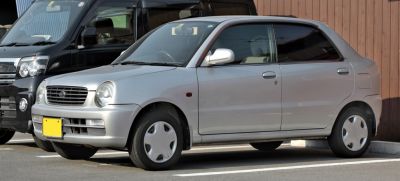 1998 Daihatsu Cuore (L701) Dimensions, Size & Specs
1998 Daihatsu Cuore (L701) Dimensions, Size & SpecsMeasurements of the 1998 Daihatsu Cuore, engineered for optimal performance and comfort
| Dimensions | |
|---|---|
| Length: | 3410 mm134.3 in11.2 ft |
| Width: | 1475 mm58.1 in4.8 ft |
| Height: | 1420 mm55.9 in4.7 ft |
| Trunk Capacity: | 155 liter5.5 cu ft |
| Trunk Capacity (Max): | 430 liter15.2 cu ft |
| Weight Specifications | |
| Curb Weight: | 720 kg1587 lbs |
| Maximal permitted Weight: | 1200 kg2646 lbs |
| Tire Specifications | |
| Tire Size: |
|
The Daihatsu Cuore (L701), produced between 1998 and 2003, is a compact hatchback designed for urban mobility and efficiency. Measuring 3410 mm (134.3 inches) in length, 1475 mm (58.1 inches) in width, and 1420 mm (55.9 inches) in height, the Cuore offers a small footprint ideal for tight city streets and easy parking. With a curb weight of just 720 kg (1587 lbs), this lightweight vehicle emphasizes fuel economy and nimble handling. Despite its compact size, the Cuore features a practical luggage capacity of 155 liters (5.5 cubic feet), which expands significantly to 430 liters (15.2 cubic feet) when the rear seats are folded down, making it versatile for everyday errands or small cargo transport. Equipped with 145/70R12 tires, the car ensures a balanced ride suitable for urban driving conditions. The maximum weight capacity is 1200 kg (2645 lbs), supporting the car’s role as a compact yet reliable hatchback. Overall, the Daihatsu Cuore (L701) combines efficient space utilization with lightweight fundamentals, catering to drivers seeking economic and practical compact transportation during the late 1990s and early 2000s.
Discover the standout features that make the 1998 Daihatsu Cuore a leader in its class
Have a question? Please check our knowledgebase first.
The Daihatsu Cuore (L701) measures 3410 mm (134.3 inches) in length, 1475 mm (58.1 inches) in width, and 1420 mm (55.9 inches) in height. These compact dimensions contribute to its classification as a small hatchback, ideal for urban environments. The narrow width and low height enhance ease of maneuvering through tight streets and parking spots, while the total length supports good interior space usage despite the car's compact footprint.
The curb weight of the Daihatsu Cuore (L701) is approximately 720 kg (1587 lbs), which refers to the weight of the vehicle without passengers, cargo, or fuel. The maximum weight capacity, including passengers and cargo, is 1200 kg (2646 lbs). This lightweight design contributes to fuel efficiency and agile handling, making it well-suited for city driving and maintaining lower running costs.
The luggage capacity of the Daihatsu Cuore (L701) is 155 liters (approximately 5.5 cubic feet) with rear seats in their upright position, which is typical for a compact hatchback of this size. When you fold down the rear seats, the available space significantly increases to 430 liters (around 15.2 cubic feet). This flexibility enhances practicality, allowing the Cuore to carry larger or more bulky items when needed.
The Daihatsu Cuore (L701) is equipped with tires sized 145/70R12. This means the tire width is 145 mm (5.7 inches), the aspect ratio (sidewall height as a percentage of the width) is 70%, and the tire fits on 12-inch diameter rims. Smaller tires like these are common on compact city cars and contribute to lower rolling resistance and maintenance costs.
Yes, the Daihatsu Cuore (L701) fits comfortably into a standard garage. With a length of 3410 mm (134.3 inches or about 11.2 feet) and a width of 1475 mm (58.1 inches or about 4.8 feet), it is smaller than most standard garage dimensions worldwide, which typically start around 2.4 meters (8 feet) in width and 4.8 meters (16 feet) in length. Additionally, the height of 1420 mm (55.9 inches or about 4.6 feet) allows it to fit under standard garage doors without difficulty.
Compared to its predecessor, the Cuore (L201) generation, the L701 model introduced in 1998 came with subtle size changes aimed at improving cabin space and comfort while maintaining the car’s compact appeal. The L701 is slightly longer and wider, enhancing passenger space and luggage capacity without increasing overall bulkiness, thus retaining its suitability as a city car. These changes reflect Daihatsu’s effort to modernize the Cuore while preserving its core practical dimensions.
When compared to similar compact hatchbacks from the late 1990s and early 2000s, like the Suzuki Alto or the Honda Life, the Daihatsu Cuore (L701) is quite competitive in size. Its length of 3410 mm and width of 1475 mm place it within the typical range for kei or city cars. Luggage space with rear seats folded to 430 liters is respectable for this segment. Its compact dimensions provide an advantage in dense urban settings, often making it smaller and easier to park than many subcompact alternatives.
The Daihatsu Cuore (L701) is designed as a 4-seat hatchback providing practical and efficient use of interior space. While compact externally, it comfortably accommodates four passengers, with a balanced seating layout optimized for short and medium trips. The cabin prioritizes passenger space, and despite its small exterior size, occupants benefit from ergonomic seating and decent headroom and legroom for a car of this class.
Given its lightweight curb mass of 720 kg and compact dimensions, the Daihatsu Cuore (L701) offers nimble and responsive handling, making it ideal for urban driving, tight corners, and busy city streets. The small tire size and lightweight chassis contribute to confident maneuverability and easy parking. While not a high-performance vehicle, its agility and ease of control are key benefits for drivers focused on practicality and efficiency in urban settings.
The Daihatsu Cuore (L701), produced from 1998 to 2003, commonly featured small-displacement gasoline engines, usually around 660 cc or 850 cc depending on the market. These engines prioritized fuel efficiency and low emissions in line with kei car regulations in Japan or similar class standards in other markets. The focus was on providing reliable, economical city commuting rather than high power output, which aligns with the car's lightweight and compact design.
Discover similar sized cars.

| Production: | 1998-2002 |
|---|---|
| Model Year: | 1999 |
| Length: | 3395 mm133.7 in |
| Width: | 1475 mm58.1 in |
| Height: | 1405 mm55.3 in |

| Production: | 2016-present |
|---|---|
| Model Year: | 2016 |
| Length: | 3427 mm134.9 in |
| Width: | 1565 mm61.6 in |
| Height: | 1450 mm57.1 in |
